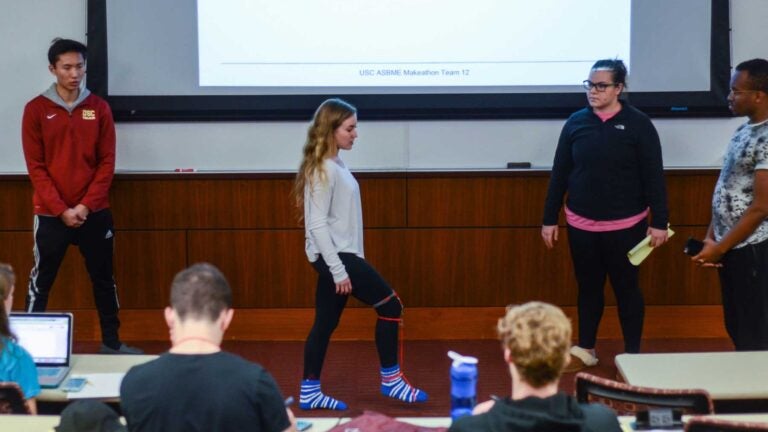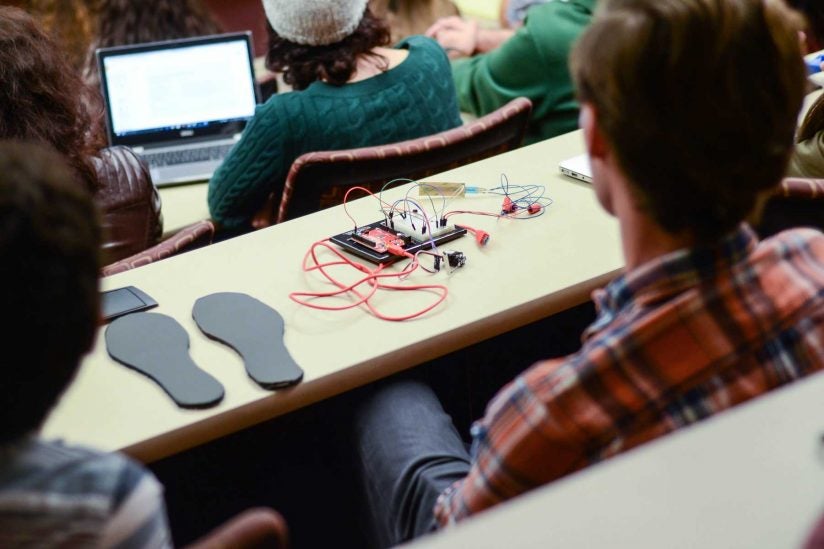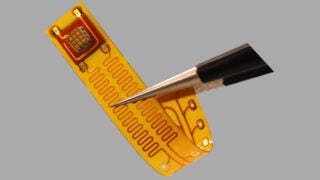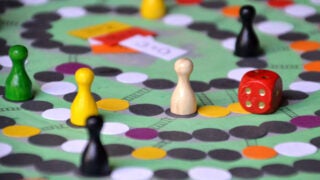
Makeathon teammates go through their paces. (Photo/Peter Shin)
Makeathon sole survivors: Teams face 30-hour deadline in USC’s biomedical challenge
This year’s mission: Design devices for a neuromuscular disorder known as ‘foot drop’
Ready: You have 30 hours to design devices for a neuromuscular disorder known as peroneal nerve injury or “foot drop.”
Set: The overnight brainstorming involves 18 teams, each with four or five students.
Go: Welcome to the second annual Makeathon, a three-day competition at USC focusing on a biomedical-related challenge.
This year’s event took place Feb. 17-19 at the Ronald Tutor Campus Center, where nearly 60 undergraduates showed up to, yes, put their best foot forward.
Close the gait
“Foot drop” is a gait abnormality in which the dropping of the forefoot happens due to weakness, irritation or damage to the common fibular nerve or paralysis of the muscles in the lower leg. It’s usually a symptom of a greater problem, not a disease in itself.
While many brace-like devices already exist for treatment, most are bulky, uncomfortable and/or expensive. Teams were encouraged to build a comfortable and affordable solution that restores natural gait, but also stabilizes the ankle, ensuring it doesn’t rotate back and forth.

Adam Seifert, president of USC’s Associated Students of Biomedical Engineering, which hosted the event, said that Makeathon spawns fast friendships since each group is required to have two upperclassmen and one underclassmen with participants often unacquainted before teams are formed.
“That’s an important part of giving people a real-world experience because when you’re working on an engineering team, you’re not going to know everyone,” Seifert said. “Everyone is going to have varying levels of experience and that’s all important to the experience that you’re going to be getting from something like this.”
Lift and lock
After team presentations, a group of PhD student-mentors selected five finalists to manufacture their devices in the USC Viterbi Undergrad Fabrication Lab. This year’s competition gave teams the option to use both electrical and mechanical components — the former was not allowed last year. Teams toiled overnight to submit their final devices by noon Sunday.
That afternoon, a panel of USC faculty members serving as judges chose the winners.
Team “Taco Tuesdays” took first place for engineering an orthosis — a device used to modify the structural characteristics of the skeletal system — with a pressure sensor in the heel of the sole.
How does it work? When the patient’s foot begins to lift, the sensor activates an electronic motor that rotates a metal pin to lock the ankle in place at the right angle. At heel strike after a step, the sensor would be triggered again to unlock the brace, allowing the patient to place his foot on the ground.
The first-place prize: a Raspberry Pi 3 microcomputer ideal for do-it-yourself projects.
Meanwhile, a collegial spirit enlivened the competition.
USC Viterbi School of Engineering sophomore Sarah Milkowski, a 2016 participant and member of this year’s “The STEMinists” team, said she returned to Makeathon because she had a great time last year.
“I think [it’s] a great opportunity to look at things like, ‘This is a great idea. This could be totally wrong, but we’re going to try it,’” said Milkowski, a biomedical engineering major. “They say you learn from failures more than successes and this is such a great opportunity for that.”



